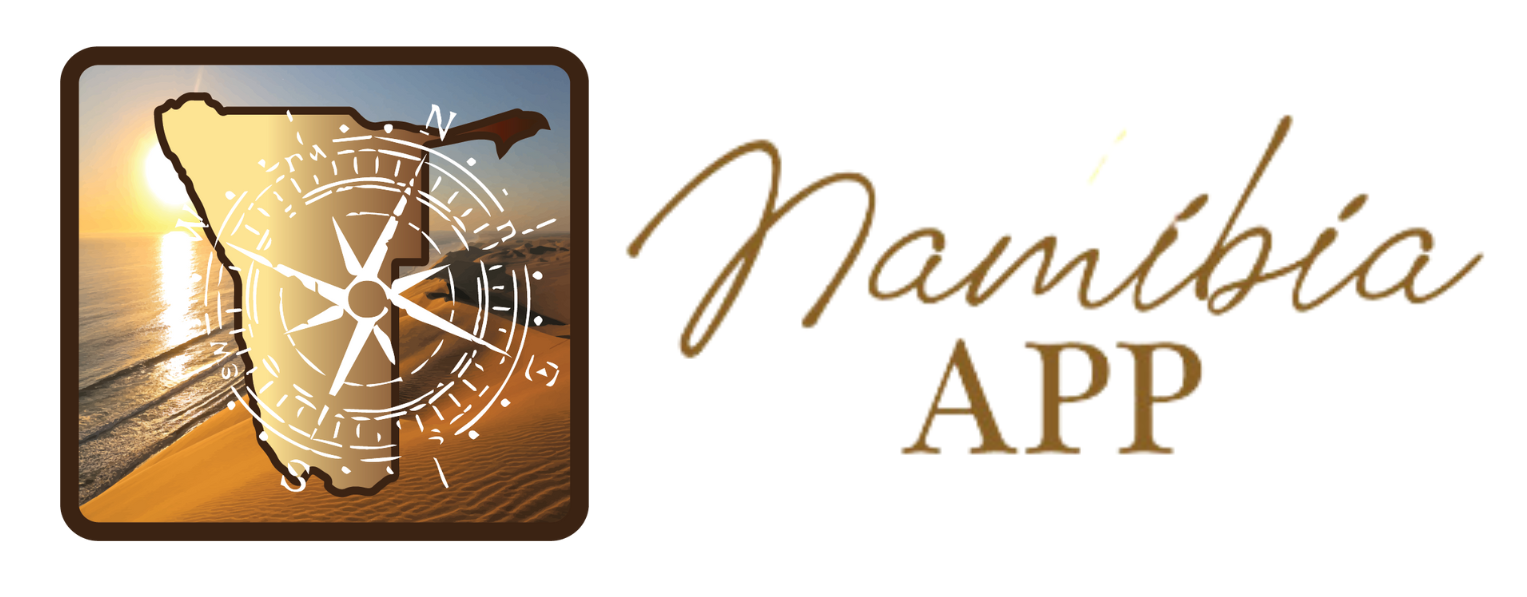Exploring Namibia's Northern Region
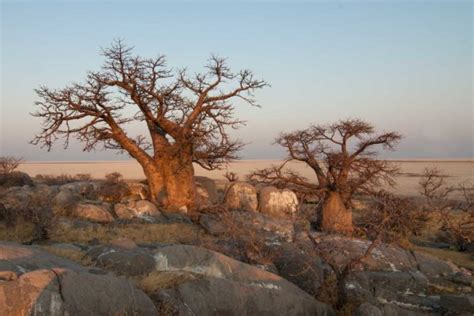
The northern region of Namibia is centred around the vast expanse of the Etosha National Park, which is one of Namibia’s most popular tourist attractions. The Park is one of the largest game parks in Africa with 114 species of mammals and over 330 species of birds stretching over an expanse of approximately 23,000 square kilometres.
The north of Namibia is a Big 5 country: Not only in the Park but also throughout the entire northern region, many species such as rhinos, buffalo, leopards, lions, antelope and giraffes can be observed either on foot or with game viewing vehicles. This activity is particularly popular around the Waterberg Plateau Park, south-east of Otjiwarongo.
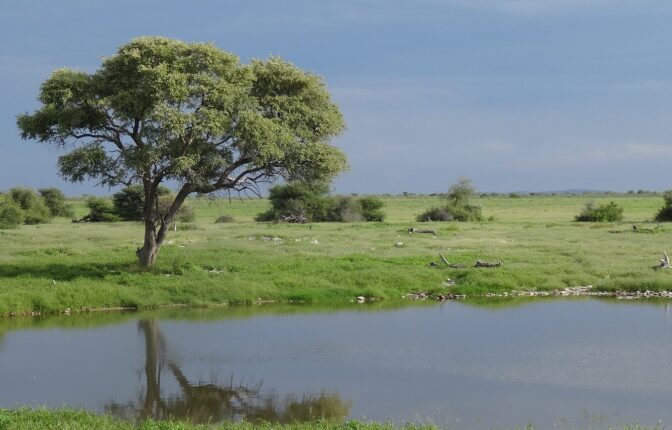
Visit the 60-ton Hoba Meteorite, the largest of its kind worldwide, just a stone’s throw from Grootfontein. Lake Otjikoto and Lake Guinas are Namibia’s two bottomless lakes, steeped in legend and folklore, situated just outside Tsumeb.
The further north one travels, the greener the countryside. The most spectacular sunsets and palm-lined horizons can be found in this region. Near the Angolan border, Namibia is most densely populated, mainly by the Owambo people.
Approximately 80% of the Namibian population lives in the north of the country. The northern people are born traders and offer their goods in cuca shops, stalls along the side of the road, or in shopping complexes.
Places of Interest in the Northern Region:
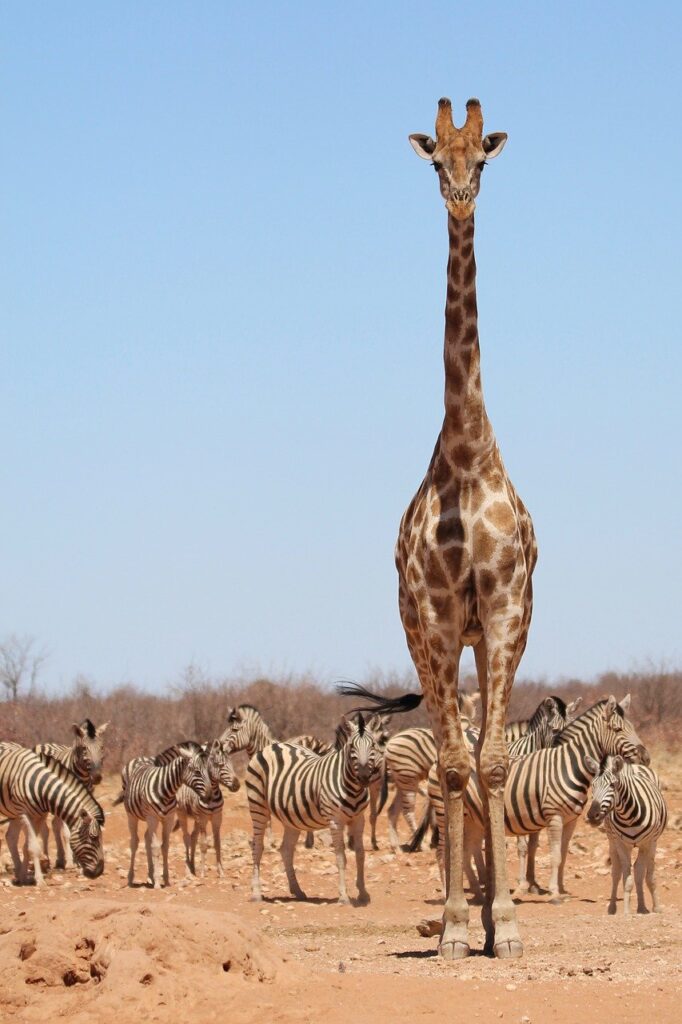
Etosha, the great white place of dry water.
It is seeing animals against the unique backdrop of the Etosha Pan — a vast expanse of desiccated white clay characterised by distant mirages and spiralling dust devils—that makes the game-viewing experience in the world-renowned Etosha National Park different to any other.
In September 2007 the park celebrated its first hundred years of existence, the centennial celebrations taking place at the Namutoni Resort in the eastern section of the park.
The park was originally proclaimed as a conservation area in 1907 by German Governor Frederich von Lindequist. This entailed the region south, west and north-west of the pan and Governor von Lindequist named it Game Reserve No. 2. (Game Reserve Nos 1 and 3 were established to the north-east and the Namib Desert respectively).
With subsequent additions Etosha became the largest game reserve in the world, extending over a vast area of approximately 80 000 square kilometres westwards across Kaokoland to the Skeleton Coast.
However, for political considerations, it was progressively diminished in size until 1975 when it was reduced by 77 per cent to its present surface area of 22 912 square kilometres.
The definitive feature of the park is the Etosha Pan, an immense, shallow depression of almost 5,000 square kilometres of dry, white cracked mud, its flat surface broken only by shimmering mirages and the occasional animal wending its way across the empty wastes.
It is this typical appearance that gave rise to the name in the local vernacular as the great white place of dry water. In the rainy season, fed by the Cuvelai system that has its origins in the highlands of Angola, floodwaters drain across Owambo. The pan fills with water and becomes an important breeding ground for migrant flamingos.
Consisting of saline desert, savannah and woodlands, Etosha’s vegetation varies from dwarf shrub savannah and grasslands to thorn-bush and woodland savannah. Mopane, Colophospermum mopane, is the dominant tree species and is found in eighty per cent of the park.
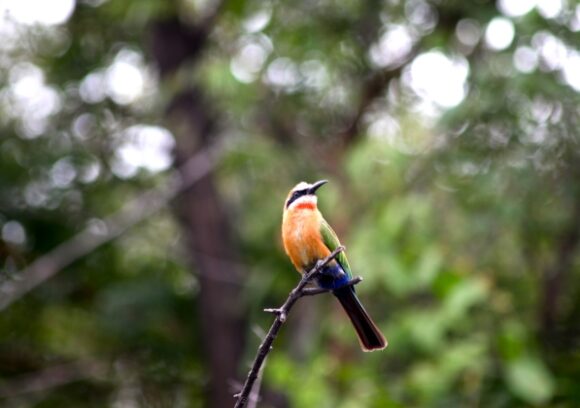
Moringa Ovalifolia (Sprokieswoud)
West of Okaukuejo a large stand of African moringa, Moringa ovalifolia, referred to as Sprokieswoud, Fairy or Phantom Forest, is the only location in Namibia where this interesting tree grows in a flat area.
A total of 114 species of mammals are found in the park, including the rare and endangered black rhino, cheetah and black-faced impala. Large mammals include giraffe, elephant, blue wildebeest, mountain and plains zebra, hyaena, leopard and lion.
The diminutive Damara dik-dik is the smallest antelope species and the largest is the stately eland, with kudu and gemsbok in between. Smaller mammals are bat-eared fox, black-backed jackal, warthog, honey badger and the endearing ground squirrel. A large number of birds occur in Etosha — about 340 — from ostrich, kori bustard and flamingos to vultures, owls, nightjars, bee-eaters and several species of waders.
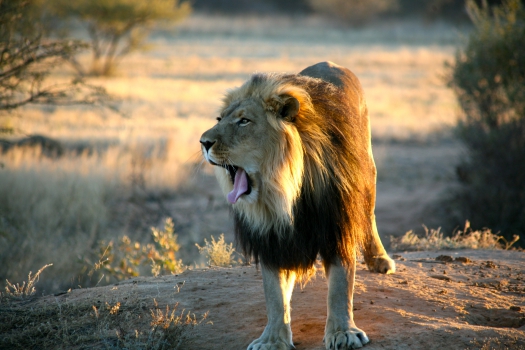
In the dry season, the best places to see the game are at the thirty-odd waterholes, which provide outstanding game-viewing and photographic opportunities. During the rainy season when there is plenty of groundwater, the animals are distributed throughout the park. The best policy is to enquire from camp staff, before setting out, what the current game movements are.
Etosha can be entered through three points: the Andersson Gate in the central southern section, the Von Lindequist Gate in the east, and the King Nehale Gate from the north-central Owambo region.
The park has three well-laid out and equipped tourism resorts: Okaukuejo in the centre of the park, Namutoni in the east and Halali halfway between the two, all three with luxury bungalows, well-equipped camping areas, information centres, restaurants, shops and museums.
Otjikoto and Guinas Lakes
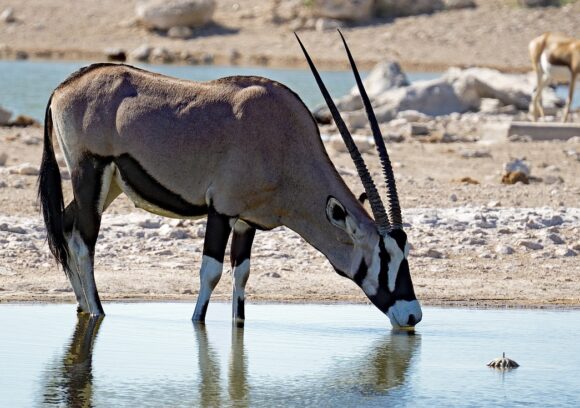
Surrounded by legend and folklore are Namibia’s two ‘bottomless’ lakes — Otjikoto, distinguished by it emerald-green waters, and Guinas, by its mystical inky-blue depths. Both lakes lie northwest of Tsumeb — Otjikoto 24 kilometres along the road and Guinas on a farm 32 kilometres further west. Lake Guinas is therefore less accessible, and can be viewed only after obtaining the farmer’s permission.
Lake Otjikoto was discovered by the two explorers Gal-ton and Andersson in 1851. At the time they measured its depth as 55 metres, an assessment that was proved accurate by subsequent plumbings (the depth varying from 33-90 metres). At 100 metres, Guinas is somewhat deeper.
However, the legend that Otjikoto was bottomless persisted. It was possibly this notion that led to the dumping of a considerable supply of artillery and ammunition into its murky depths by retreating Schutztruppe, rather than letting the armaments fall into the hands of the South African troops.
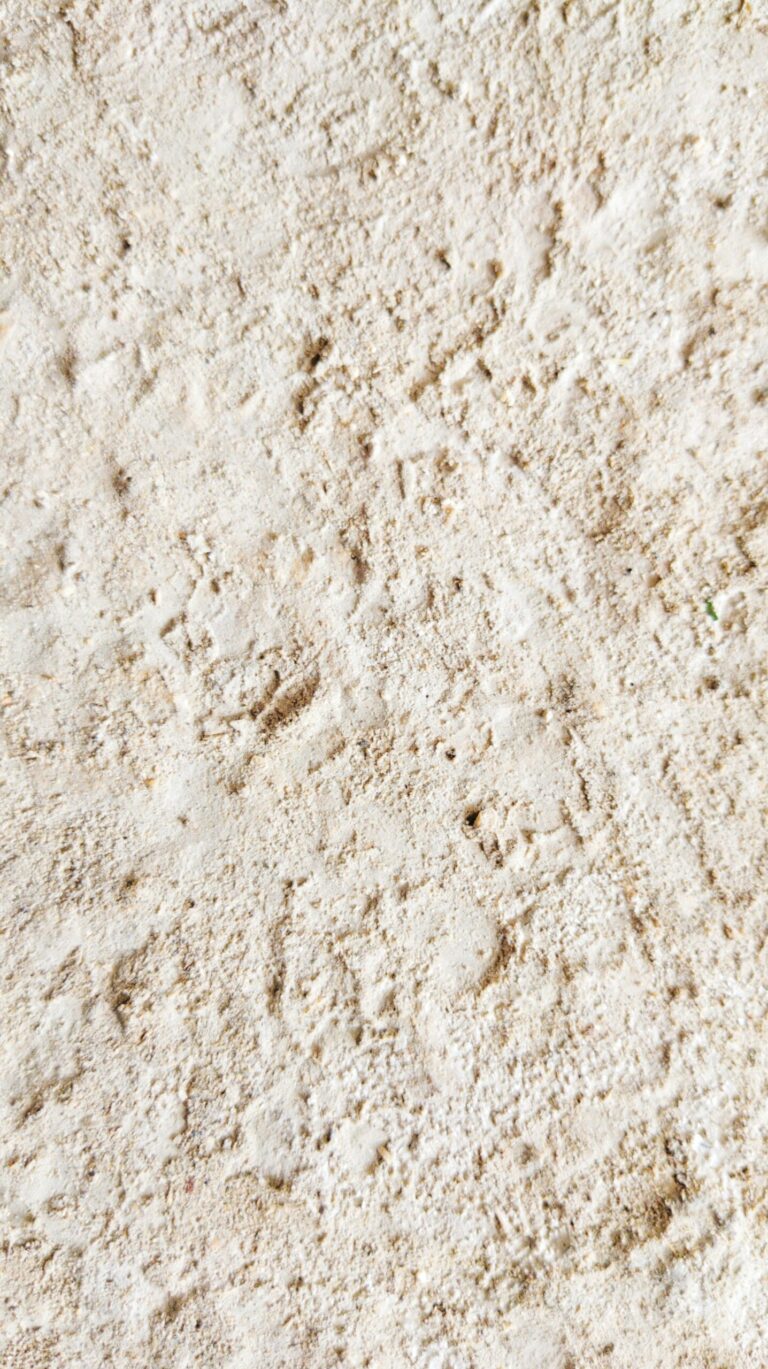
Many years later, in co-operation with the Windhoek State Museum, divers salvaged some of the equipment, among others an ammunition wagon still in perfect condition, which can be viewed in the Alte Feste Museum in Windhoek, and canons and other armaments that were restored and are now displayed in the Tsumeb Museum.
One of the many legends that surround Lake Otjikoto is that the body of Johannes Cook, a postmaster of Tsumeb who drowned there in 1927, was never found because the lake was bottomless. Because Otjikoto is shaped rather like an upside-down mushroom, it is thought that his body was caught under one of the overhangs.
Both these lakes lie in the Otavi mountainland, which consists of a thick succession of well-stratified dolomite and limestone about 700 million years old.
Being carbonates of calcium and magnesium, these rocks are soluble in water, especially if they contain some carbon dioxide. The rocks are crisscrossed by a system of solution channels that have generally developed on joints, fracture zones or bedding planes, which become partially filled with groundwater.
Now and then big cavities are exposed by weathering, or the roof caves in when it becomes very thin, as in the case of Otjikoto and Guinas. These solution channels lead away from them, although the two lakes need not necessarily be directly connected. The lakes are fed by water seeping through the porous rock from southern Owambo.
Cheetah Conservation Fund
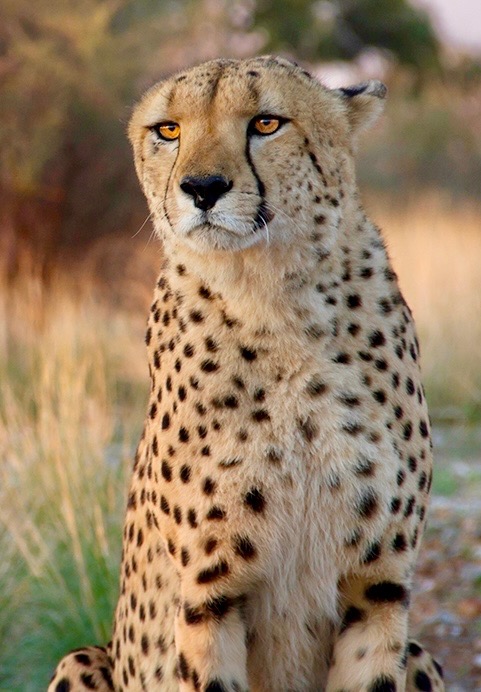
Founded in 1990 by Dr. Laurie Marker, the Cheetah Conservation Fund is located at the base of the Waterberg Plateau Park on a large private nature reserve east of Otjiwarongo, the Cheetah Capital of the world.
Namibia is home to the largest concentration of free-ranging cheetah, which is approximately 30% of the world’s population. Dr. Marker is the Founder and Executive Director of CCF, a conservation biologist, researcher and author who is recognised as one of the world’s leading cheetah experts.
Laurie’s tireless work to unite a nation, a continent and the world to save the cheetah is impressive. She has received almost every major international award given in her field and 2000, was named one of Time Magazine’s Heroes for the Planet.
While CCF is home to resident non-releasable cheetahs, it is not a sanctuary, but rather a world-class research and education centre that is open to the public, maintaining a specialised veterinary clinic, visitor centre, museum and model farm that sets the standard for cheetah management and conservation worldwide.
CCF works actively to develop integrated programmes that enable the cheetah to live in harmony with people on the land. Since 90% of wild cheetahs live on or near livestock farms, CCF’s Namibian focus is to work with farming communities to reduce conflict; establish sustainable, integrated livestock and wildlife management systems; and ensure the future of the cheetah.
Human/Wildlife Conflict Resolution
Through its groundbreaking Future Farmers of Africa Programme, CCF teaches farmers predator-friendly livestock management techniques to encourage acceptance of cheetahs as part of the ecosystem.
The use of dogs to guard livestock is one of the most popular and successful methods. CCF’s Livestock Guarding Dog Programme uses two rare dog breeds from Turkey, the Anatolian shepherd and Kangal, which have been used for 6,000 years to protect sheep from wolves.
The dogs do not herd the flock but place themselves between livestock and approaching predators. If the dog’s loud bark does not scare the predator away, the dog will attack. To date, CCF has placed hundreds of dogs on Namibian livestock farms, and those farms report an 80% decrease in livestock losses attributable to predation.
CCF’s main focus is to change people’s attitudes about cheetahs and predators in general by teaching young people about the importance of biodiversity. The education centre hosts thousands of students each year and education officers conduct assemblies at schools throughout Namibia. CCF’s educational efforts have produced a new generation that is proud of its wildlife — including predators — and will help fight to save them.
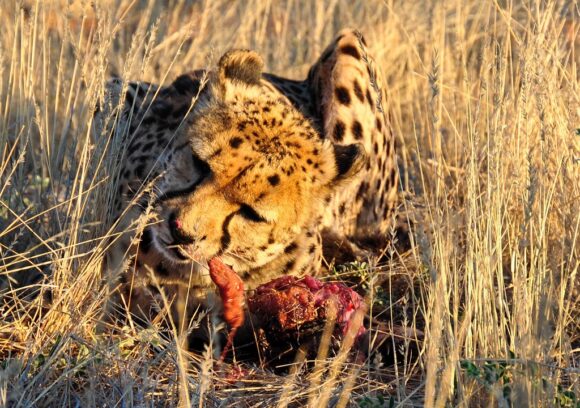
CCF Welcomes Visitors
Cheetah Conservation Fund is open to the public and welcomes visitors 364 days a year (closed on December 25). Visiting hours are 9 a.m. to 5 p.m. daily. CCF is located on the D2440, which goes off the B1 from Otjiwarongo towards Otavi. It is an ideal stop-over on the way to the North.
Activities
Visitors can tour CCF’s Education Centre and learn about the cheetah’s history at the Cheetah Museum. The tour also includes the opportunity to observe resident cheetahs dine (Monday-Friday at 2 p.m.; Saturday & Sunday at noon).
Or, visitors can take a three-hour safari drive through CCF’s Bellebenno Game Camp (pre-booking required), or a drive through the Elandsvreugde Cheetah Pen closer to CCF’s Visitor Centre (one hour, no advance notice required).
